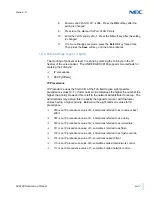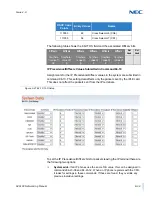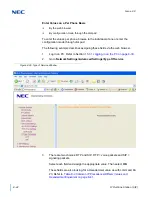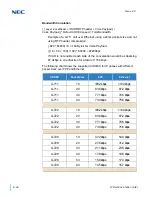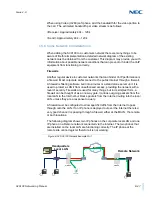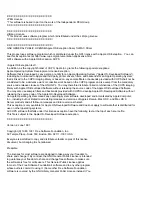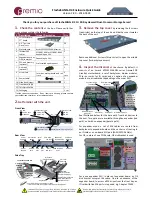
Issue 2.0
SV9100 Networking Manual
8-37
8.
Enter a valid VLAN ID of 1~4094. Press the
OK
soft key after the
setting is changed.
9.
Press
4
on the dial pad for Port VLAN Priority.
10.
Enter the VLAN priority of 0~7. Press the
OK
soft key after the setting
is changed.
11.
If no more changes are made, press the
Exit
soft key three times.
Then press the
Save
soft key, and the phone reboots.
15.4 ToS Settings (Layer 3 QoS)
The marking of packets at layer 3 is done by marking the ToS byte in the IP
header of the voice packet. The UNIVERGE SV9100 supports two methods for
marking the ToS byte:
IP precedence
DSCP (Diffserv)
IP Precedence
IP Precedence uses the first 3 bits of the ToS field to give eight possible
precedence values (0~7). Under normal circumstances the higher the number the
higher the priority. However this is left to the network administrator for setup. The
administrator may assign this in exactly the opposite manner with the lower
values having a higher priority. Below are the eight common values for IP
precedence.
000 is an IP precedence value of 0, sometimes referred to as routine or best
effort.
001 is an IP precedence value of 1, sometimes referred to as priority.
010 is an IP precedence value of 2, sometimes referred to as immediate.
011 is an IP precedence value of 3, sometimes referred to as flash.
100 is an IP precedence value of 4, sometimes referred to as flash override.
101 is an IP precedence value of 5, sometimes called critical.
110 is an IP precedence value of 6, sometimes called Internetwork control.
111 is an IP precedence value of 7, sometimes called network control.
Summary of Contents for Univerge SV9100
Page 1: ...Networking Manual A50 035910 004 AU Issue 2 0...
Page 20: ...xviii Table of Contents Issue 2 0...
Page 26: ...xxiv List of Figures Issue 2 0...
Page 33: ...Book 1 SV9100 K CCIS...
Page 49: ...Issue 2 0 1 16 General Information US Only Figure 1 15 Circuit Identification Codes CIC...
Page 53: ...Issue 2 0 1 20 General Information US Only...
Page 61: ...Issue 2 0 2 8 Hardware Installation US Only...
Page 195: ...Issue 2 0 4 116 Features and Specifications...
Page 242: ...Book 2 SV9100 IP Networking...
Page 256: ...Issue 2 0 2 12 IP Networking...
Page 312: ...Issue 2 0 4 48 Programming...
Page 376: ...Issue 2 0 6 30 SIP Trunking...
Page 391: ...Issue 2 0 7 14 H 323 Trunking...
Page 467: ...Issue 2 0 8 76 IP Multiline Station SIP...
Page 551: ...Issue 2 0 10 64 SV9100 NetLink Conditions None Feature Cross Reference None...
Page 567: ...Issue 2 0 10 80 SV9100 NetLink Conditions None Feature Cross Reference None...
Page 579: ...Issue 2 0 11 6 NAPT...
Page 580: ...Issue 2 0 SV9100 Networking Manual 11 7...
Page 581: ...Issue 2 0 11 8 NAPT...
Page 582: ...Issue 2 0 SV9100 Networking Manual 11 9...
Page 583: ...Issue 2 0 11 10 NAPT...
Page 584: ...Issue 2 0 SV9100 Networking Manual 11 11...
Page 595: ...Issue 2 0 12 4 All DSP Busy Indication...
Page 671: ...Issue 2 0 13 76 AspireNet Conditions None Feature Cross Reference None...
Page 685: ...Issue 2 0 13 90 AspireNet Department Calling Flexible System Numbering Intercom...
Page 707: ...Issue 2 0 13 112 AspireNet Default Trunk Port Number Name 1 Line 001 2 Line 002 400 Line 400...
Page 713: ...Issue 2 0 13 118 AspireNet Department Calling...
Page 765: ...Issue 2 0 13 170 AspireNet...















